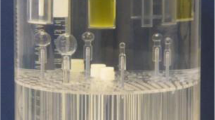Abstract
A need exists to measure the absolute sensitivity of a positron emission tomographic (PET) scanner in units of counts. s−1.MBq−1. At present sensitivity is generally determined by measurement of a radionuclide of known concentration distributed in a water-filled cylindrical phantom, usually 20 cm in diameter. The measurement is confounded by self-attenuation of the source and scatter within the cylinder and does not give a true absolute sensitivity measurement. Due to variations in the magnitude and treatment of these factors, meaningful comparison between different manufacturer's scanners is difficult, as are comparisons between different acquisition geometries (e.g. with and without interplane septa present). A method has been developed in our laboratory that provides measurements of absolute sensitivity in air for a scanner independent of attenuation and scatter within the source. The method involves measurements of a thin-line source of fluorine 18 contained within an aluminium housing to which successive aluminium sleeves are added. The extrapolation of these measurements allows an effective counts. s−1.MBq−1 measurement to be made for zero thickness of aluminium. Measurements have yielded absolute sensitivities of 3 926 ± 61 counts. s−1.MBq−1 (0.39% efficiency), 5079±26 counts. s−1.MBq−1 (0.51%), and 32312±544 counts. s−1.MBq−1 (3.2%) for a whole-body PET scanner with interplane septa and for a NeuroPET operating with and without interplane septa, respectively.
Similar content being viewed by others
References
Axelsson B, Msaki P, Israelsson A (1984) Subtraction of Compton-scattered photons in single-photon emission computerized tomography. J Nucl Med 25:490–494
Bailey DL, Hutton BF, Meikle SR, Fulton RR, Jackson CBJ (1989) Iterative scatter correction incorporating attenuation data. Eur J Nucl Med 15:452
Bailey DL, Jones T, Spinks TJ, Gilardi M-C, Townsend DW (1991) Noise equivalent count measurements in a Neuro-PET scanner with retractable septa. IEEE Trans Med Imag (in press)
Carroll LR, Kertz P, Orcut G (1983) The orbiting rod source: improving performance in PET transmission correction scans. In: Emission computed tomography: current trends. The Society of Nuclear Medicine, New York
Derenzo SE, Budinger TF, Cahoon JL, Huesman RH, Jackson HG (1977) High resolution computed tomography of Positron Emitters. IEEE Trans Nucl Sci NS-24:544–558
Hubbel JH (1969) NBS Publ. NSRDS-NBS 29
ICRU Report 37 (1984) pp 214–215
Lederer CM, Shirley VS (eds) (1978) Table of isotopes, 7th edn. Wiley, Chichester New York
Murphy PH (1987) Quantitative emission tomography. J Nucl Med 28:922–923
Paans AMJ, Lamotte DW (1989) Sensitivity and cross calibration. Eur J Nucl Med 15:756–760
Ranger NT, Thompson CJ, Evans AC (1989) The application of a masked transmission source for attenuation correction in PET. J Nucl Med 30:1056–1068
Spinks TJ, Jones T, Gilardi MC, Heather JD (1988) Physical performance of the latest generation of commercial positron scanner. IEEE Trans Nucl Sci 35:721–725
Spinks TJ, Jones T, Heather JD, Gilardi M-C (1989) Quality control procedures in positron tomography. Eur J Nucl Med 15:736–740
Strother SC, Casey ME, Hoffman EJ (1990) Measuring PET scanner sensitivity: relating count rates to image signal-to-noise ratios using noise equivalent counts. IEEE Trans Nucl Sci 37:783–788
Thompson CJ, Dagher A, Lunney DN, Strother SC, Evans AC (1986) A technique to reject scattered radiation in PET transmission scans. In: Nalciouglu O, Cho ZH, Budinger TF (eds) International workshop on physics and engineering of computerized multidimensional imaging and processing. Proc SPIE 671:244–253
Townsend D, Spinks TJ, Jones T, Geissbühler A, Defries M, Gilardi M-C (1989) Aspects of three dimensional reconstruction for a multi-ring positron tomograph. Eur J Nucl Med 15:741–745
Townsend DW, Geissbühler A, Defrise M, Hoffman EJ, Spinks TJ, Bailey DL, Gilardi M-C, Jones T (1991) Fully three-dimensional reconstruction for a PET camera with retractable septa. IEEE Trans Med Imag (in press)
Author information
Authors and Affiliations
Rights and permissions
About this article
Cite this article
Bailey, D.L., Jones, T. & Spinks, T.J. A method for measuring the absolute sensitivity of positron emission tomographic scanners. Eur J Nucl Med 18, 374–379 (1991). https://doi.org/10.1007/BF02258426
Received:
Revised:
Issue Date:
DOI: https://doi.org/10.1007/BF02258426




